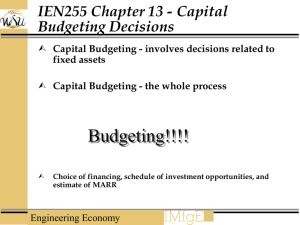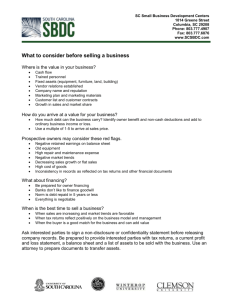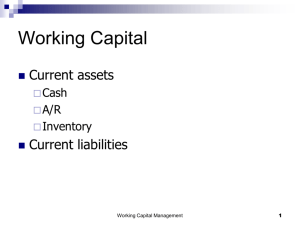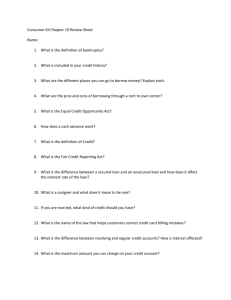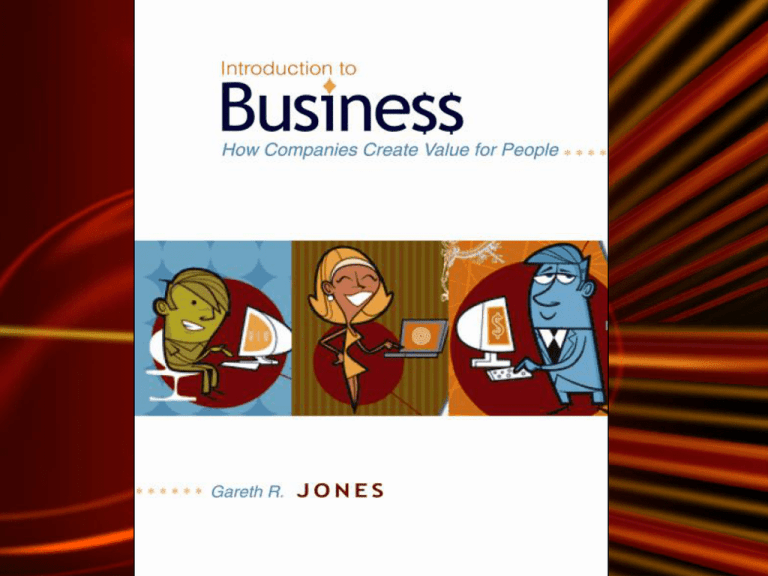
Chapter Fifteen
Finance: Balancing Risk
and Return to Increase
Profitability
McGraw-Hill/Irwin
Introduction to Business
© 2007 The McGraw-Hill Companies, Inc., All Rights Reserved.
Learning Objectives
1. Appreciate the crucial relationship between
risk and return and the way it affects all
business finance decisions.
2. Understand short-term capital management
and the tools managers use to increase the
rate of return on capital.
3. Understand long-term capital management
and the tools used to manage it, like net
present value and breakeven analysis.
15 - 3
Learning Objectives
4. Describe four different methods companies
can use to finance capital investments.
5. Differentiate between the roles debt and equity
securities play in financial decision making.
15 - 4
What is Finance?
• Finance
- the set of activities people and companies
engage in to decide how to invest their
capital so that it generates more cash,
profit, and wealth
15 - 5
The Relationship Between Risk
and Return
Value of the Asset Now – Value at Time of Purchase X 100
Value of the Asset at Time of Purchase
15 - 6
Question?
What is the extra reward investors demand
for bearing the additional risks
associated with a speculative
investment?
A. Speculation
B. Bond portfolio
C. Risk premium
D. Risk leverage
15 - 7
The Relationship Between Risk
and Return
• Risk premium
- the extra reward investors demand for
bearing the additional risks associated with
a speculative
investment
15 - 8
Business Finance
• The role of business finance is to ensure
that the methods a company uses to
borrow, invest, spend, and even lend
capital lead to a rate of return that
maximizes the present market value of its
stock
15 - 9
The Cycle of Profit
Figure 15.1
15 - 10
Four Ways to Use Capital
Figure 15.2
15 - 11
Capital Investment and Budgeting
• Capital investment and budgeting
- the development of a financial plan and
budget to manage and invest capital so that
it leads to the highest return on invested
capital that can be obtained
15 - 12
Short-Term Capital Management
Decisions
• Short-term capital management
- the financial decisions involved when a
company purchases resources to make
products that will be sold within a one-year
period
15 - 13
Managing the Short-Term
Operating Cycle
Figure 15.3
15 - 14
Long-Term Capital Budgeting
Decisions
• Long-term capital budgeting
- the financial decisions involved when a
company chooses how to invest capital for
extended periods of time
15 - 15
Long-Term Capital Budgeting
Decisions
• Net present value analysis
- the financial analysis needed to determine
the true rate of return of a proposed capital
investment
- tells a manager how much a long-term
project would earn in today’s dollars
15 - 16
Long-Term Capital Budgeting
Decisions
• Breakeven point
- the sales level that just covers all of a
project’s costs but where no profit is earned
• Variable costs
- costs that are only incurred when the firm
makes and sells products
15 - 17
Breakeven Analysis
Figure 15.4
15 - 18
Long-Term Capital Budgeting
Decisions
• Capital budget
- a set of rules for allocating funds to the
different functions of a firm to achieve a
predetermined rate of return on its
investment
15 - 19
Breakeven Analysis and
Inventory Turnover
Figure 15.4
15 - 20
A Company as a Portfolio of
Investments
• Brand manager
- a manager
responsible for
managing a
brand-name
product
15 - 21
Capital Financing
• Capital financing
- the development of a financial plan to allow
a company to obtain the money it needs to
fund its activities at the lowest possible cost
15 - 22
Short-Term Financing Methods
• Cash reserves
• Unsecured and secured loans
• Accounts receivable financing
• Commercial paper
15 - 23
Question?
What is a loan not backed by valuable
assets pledged to guarantee the loan will
be paid back?
A. Secured loan
B. Unsecured loan
C. Line of credit
D. Commercial paper
15 - 24
Short-Term Financing Methods
• Unsecured loan
- a loan not backed by valuable assets
pledged to guarantee the loan will be paid
back
• Line of credit
- a short-term unsecured loan a company
can draw against as its accounts payable
become due
15 - 25
Short-Term Financing Methods
• Secured loan
- a loan backed by valuable fixed or current
assets
• Commercial paper
- short-term, unsecured debts or notes
issued at a certain rate of interest for up to
nine months
15 - 26
Long-Term Financing Methods
• Leverage
- the ability to use borrowed capital in ways
that have the potential to lead to high rates
of return
15 - 27
Methods of Obtaining New Capital
Figure 15.6
15 - 28
Long-Term Financing Methods
• Hedge funds
- mutual funds that use highly leveraged
investments to try to rapidly increase
investors’ capital
returns
15 - 29
Long-Term Financing Methods
• Principal
- the amount of money originally borrowed
• Capital structure
- the balance between the amount of capital
a company raises through debt and the
amount it raises through equity
15 - 30
Debt Securities: Bonds
• Debt securities
- investment documents that provide
evidence of a company’s legal obligation to
repay within a certain period of time the
money it borrows and make regular interest
payments on that money in the meantime
15 - 31
Debt Securities: Bonds
• Bonds
- common types of debt securities issued by
a company for a period of more than one
year
Find out how to buy bonds at eHow.com
15 - 32
Debt Securities: Bonds
• Call provision
- a company’s legal right to buy its bonds
back early from bondholders to avoid high
interest-rate payments
15 - 33
Debt Securities: Bonds
• Current yield
- a financial measure of a bond’s current rate
of return
- obtained by dividing the bond’s original
interest rate by its current closing price
15 - 34
How to Read a Corporate
Bond Table
Figure 15.7
15 - 35
Equity Securities: Stocks
• Equity securities
- the capital stock certificates a company
issues giving shareholders the legal right to
its assets and dividends from its profits
15 - 36
Equity Securities: Stocks
• Initial public offering
- the first time the
owners of a
company’s stock
offer it for sale to
the general public
15 - 37
Types of Stock
• Blue-chip
• Growth
• Income
• Speculative
15 - 38
Equity Securities: Stocks
• Price-to-earnings ratio
- a way of valuing a stock by dividing its
closing price by its annual earnings per
share
15 - 39
Non-Operations Investing and
Financing
• Treasury stock
- stock a company buys back from the public
and becomes part of stockholders’ equity
on the firm’s balance sheet
15 - 40
Video: Jack Welch
•
•
Several questions are asked of Jack
Welch who at the time of this interview
had recently authored his book,
“Winning.”
What is the best thing about being a
manager, according to Welch?
15 - 41



